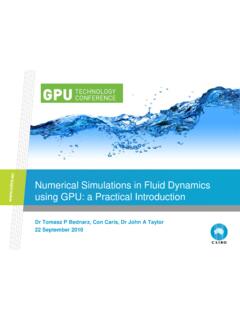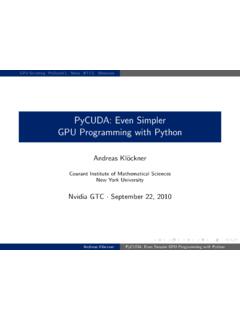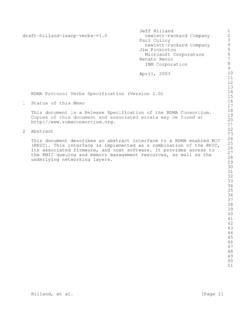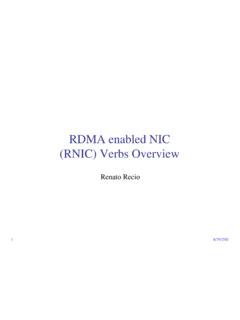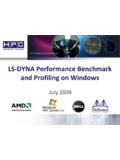Transcription of Support for GPUs with GPUDirect RDMA in MVAPICH2
1 Support for GPUs with GPUD irect RDMA in MVAPICH2 Panda The Ohio State University E-mail: ~panda SC 13 NVIDIA Booth by Overview of MVAPICH2 -GPU Project GPUD irect RDMA with Mellanox IB adaptors Other Optimizations for GPU Communication Support for MPI + OpenACC CUDA and OpenACC extensions in OMB 2 Outline SC'13 NVIDIA Booth presentation Drivers of Modern HPC Cluster Architectures Multi-core processors are ubiquitous and InfiniBand is widely accepted MVAPICH2 has constantly evolved to provide superior performance Accelerators/Coprocessors are becoming common in high-end systems How does MVAPICH2 help development on these emerging architectures? Accelerators / Coprocessors high compute density, high performance/watt >1 TFlop DP on a chip High Performance Interconnects - InfiniBand <1usec latency, >100 Gbps Bandwidth Tianhe 2 (1) Titan (2) Stampede (6) Tianhe 1A (10) 3 Multi-core Processors SC'13 NVIDIA Booth presentation Many systems today have both GPUs and high-speed networks such as InfiniBand Problem: Lack of a common memory registration mechanism Each device has to pin the host memory it will use Many operating systems do not allow multiple devices to register the same memory pages Previous solution.
2 Use different buffer for each device and copy data SC'13 NVIDIA Booth presentation 4 InfiniBand + GPU systems (Past) Collaboration between Mellanox and NVIDIA to converge on one memory registration technique Both devices register a common host buffer GPU copies data to this buffer, and the network adapter can directly read from this buffer (or vice-versa) Note that GPU-Direct does not allow you to bypass host memory 5 GPU-Direct SC'13 NVIDIA Booth presentation PCIe GPU CPU NIC Switch At Sender: cudaMemcpy(s_hostbuf, s_devbuf, ..); MPI_Send(s_hostbuf, size, ..); At Receiver: MPI_Recv(r_hostbuf, size, ..); cudaMemcpy(r_devbuf, r_hostbuf, ..); Data movement in applications with standard MPI and CUDA interfaces High Productivity and Low Performance 6 SC'13 NVIDIA Booth presentation MPI + CUDA Users can do the Pipelining at the application level using non-blocking MPI and CUDA interfaces Low Productivity and High Performance At Sender: At Receiver: MPI_Recv(r_devbuf, size.)
3 ; inside MVAPICH2 Standard MPI interfaces used for unified data movement Takes advantage of Unified Virtual Addressing (>= CUDA ) Optimizes data movement from GPU memory High Performance and High Productivity MPI_Send(s_devbuf, size, ..); 7 SC'13 NVIDIA Booth presentation GPU-Aware MPI Library: MVAPICH2 -GPU Pipelined Data Movement in MVAPICH2 -45% improvement compared with a na ve (Memcpy+Send) -24% improvement compared with an advanced user-level implementation (MemcpyAsync+Isend) 05001000150020002500300032K128K512K2 MTime (us) Message Size (bytes) Memcpy+SendMemcpyAsync+IsendMVAPICH2-GPU 8 SC'13 NVIDIA Booth presentation Better Pipelines data movement from the GPU, overlaps -device-to-host CUDA copies -inter-process data movement (network transfers or shared memory copies) -host-to-device CUDA copies Internode osu_latency large Overview of MVAPICH2 -GPU Project GPUD irect RDMA with Mellanox IB adaptors Other Optimizations for GPU Communication Support for MPI + OpenACC CUDA and OpenACC extensions in OMB 9 Outline SC'13 NVIDIA Booth presentation Network adapter can directly read/write data from/to GPU device memory Avoids copies through the host Fastest possible communication between GPU and IB HCA Allows for better asynchronous communication OFED with GDR Support is under development by Mellanox and NVIDIA GPU-Direct RDMA (GDR)
4 With CUDA InfiniBand GPU GPU Memory CPU Chip set System Memory 10 MVAPICH User Group Meeting 2013 SC'13 NVIDIA Booth presentation OFED with Support for GPUD irect RDMA is under work by NVIDIA and Mellanox OSU has an initial design of MVAPICH2 using GPUD irect RDMA Hybrid design using GPU-Direct RDMA GPUD irect RDMA and Host-based pipelining Alleviates P2P bandwidth bottlenecks on SandyBridge and IvyBridge Support for communication using multi-rail Support for Mellanox Connect-IB and ConnectX VPI adapters Support for RoCE with Mellanox ConnectX VPI adapters SC'13 NVIDIA Booth presentation 11 GPU-Direct RDMA (GDR) with CUDA IB Adapter System Memory GPU Memory GPU CPU Chipset P2P write: GB/s P2P read: < GB/s SNB E5-2670 P2P write: GB/s P2P read: GB/s IVB E5-2680V2 SNB E5-2670 / IVB E5-2680V2 12 Performance of MVAPICH2 with GPU-Direct-RDMA: Latency GPU-GPU Internode MPI Latency SC'13 NVIDIA Booth presentation 01002003004005006007008008K32K128K512K2M 1-Rail2-Rail1-Rail-GDR2-Rail-GDRL arge Message Latency Message Size (bytes) Latency (us) Based on Intel Ivy Bridge (E5-2680 v2) node with 20 cores NVIDIA Telsa K40c GPU, Mellanox Connect-IB Dual-FDR HCA CUDA , Mellanox OFED with GPU-Direct-RDMA Patch 10 % 05101520251416642561K4K1-Rail2-Rail1-Rai l-GDR2-Rail-GDRS mall Message Latency Message Size (bytes) Latency (us) 67 % usec 13 Performance of MVAPICH2 with GPU-Direct-RDMA.
5 Bandwidth GPU-GPU Internode MPI Uni-Directional Bandwidth SC'13 NVIDIA Booth presentation 0200400600800100012001400160018002000141 6642561K4K1-Rail2-Rail1-Rail-GDR2-Rail-G DRS mall Message Bandwidth Message Size (bytes) Bandwidth (MB/s) 0200040006000800010000120008K32K128K512K 2M1-Rail2-Rail1-Rail-GDR2-Rail-GDRL arge Message Bandwidth Message Size (bytes) Bandwidth (MB/s) Based on Intel Ivy Bridge (E5-2680 v2) node with 20 cores NVIDIA Telsa K40c GPU, Mellanox Connect-IB Dual-FDR HCA CUDA , Mellanox OFED with GPU-Direct-RDMA Patch 5x GB/s 14 Performance of MVAPICH2 with GPU-Direct-RDMA: Bi-Bandwidth Based on Intel Ivy Bridge (E5-2680 v2) node with 20 cores NVIDIA Telsa K40c GPU, Mellanox Connect-IB Dual-FDR HCA CUDA , Mellanox OFED with GPU-Direct-RDMA Patch GPU-GPU Internode MPI Bi-directional Bandwidth SC'13 NVIDIA Booth presentation 0200400600800100012001400160018002000141 6642561K4K1-Rail2-Rail1-Rail-GDR2-Rail-G DRS mall Message Bi-Bandwidth Message Size (bytes) Bi-Bandwidth (MB/s) 05000100001500020000250008K32K128K512K2M 1-Rail2-Rail1-Rail-GDR2-Rail-GDRL arge Message Bi-Bandwidth Message Size (bytes) Bi-Bandwidth (MB/s) 19 % 19 GB/s How can I get started with GDR Experimentation?
6 Two modules are needed Alpha version of OFED kernel and libraries with GPUD irect RDMA (GDR) Support from Mellanox Alpha version of MVAPICH2 -GDR from OSU (currently a separate distribution) Send a note to You will get alpha versions of GDR driver and MVAPICH2 -GDR (based on MVAPICH2 release) You can get started with this version MVAPICH2 team is working on multiple enhancements (collectives, datatypes, one-sided) to exploit the advantages of GDR As GDR driver matures, successive versions of MVAPICH2 -GDR with enhancements will be made available to the community 15 SC'13 NVIDIA Booth presentation Overview of MVAPICH2 -GPU Project GPUD irect RDMA with Mellanox IB adaptors Other Optimizations for GPU Communication Support for MPI + OpenACC CUDA and OpenACC extensions in OMB 16 Outline SC'13 NVIDIA Booth presentation Multi-GPU Configurations 17 CPU GPU 1 GPU 0 Memory I/O Hub Process 0 Process 1 Multi-GPU node architectures are becoming common Until CUDA Communication between processes staged through the host Shared Memory (pipelined) Network Loopback [asynchronous) CUDA and later Inter-Process Communication (IPC)]
7 Host bypass Handled by a DMA Engine Low latency and Asynchronous Requires creation, exchange and mapping of memory handles - overhead HCA SC'13 NVIDIA Booth presentation 05001000150020004K16K64K256K1M4 MLatency (usec) Message Size (Bytes) 010203040501416642561 KLatency (usec) Message Size (Bytes) SHARED-MEMCUDA IPC18 Designs in MVAPICH2 and Performance 70% 46% SC'13 NVIDIA Booth presentation MVAPICH2 takes advantage of CUDA IPC for MPI communication between GPUs Hides the complexity and overheads of handle creation, exchange and mapping Available in standard releases from MVAPICH2 Intranode osu_latency large Intranode osu_latency small 01000200030004000500060001162564K64K1 MBandwidth (MBps) Message Size (Bytes) 78% Intranode osu_bw 19 Collectives Optimizations in MVAPICH2 : Overview SC'13 NVIDIA Booth presentation Optimizes data movement at the collective level for small messages Pipelines data movement in each send/recv operation for large messages Several collectives have been optimized -Bcast, Gather, Scatter, Allgather, Alltoall, Scatterv, Gatherv, Allgatherv.
8 Alltoallv Collective level optimizations are completely transparent to the user Pipelining can be tuned using point-to-point parameters MPI Datatype Support in MVAPICH2 20 Multi-dimensional data Row based organization Contiguous on one dimension Non-contiguous on other dimensions Halo data exchange Duplicate the boundary Exchange the boundary in each iteration Halo data exchange SC'13 NVIDIA Booth presentation Non-contiguous Data Exchange MPI Datatype Support in MVAPICH2 Datatypes Support in MPI Operate on customized datatypes to improve productivity Enable MPI library to optimize non-contiguous data SC'13 NVIDIA Booth presentation 21 At Sender: MPI_Type_vector (n_blocks, n_elements, stride, old_type, &new_type); MPI_Type_commit(&new_type); .. MPI_Send(s_buf, size, new_type, dest, tag, MPI_COMM_WORLD); Inside MVAPICH2 -Use datatype specific CUDA Kernels to pack data in chunks -Optimized vector datatypes Kernel based pack/unpack in MVAPICH2 -Efficiently move data between nodes using RDMA -Transparent to the user H.
9 Wang, S. Potluri, D. Bureddy, C. Rosales and D. K. Panda, GPU-aware MPI on RDMA-Enabled Clusters: Design, Implementation and Evaluation, IEEE Transactions on Parallel and Distributed Systems, Accepted for Publication. 22 Application Level Evaluation (LBMGPU-3D) LBM-CUDA (Courtesy: Carlos Rosale, TACC) - Lattice Boltzmann Method for multiphase flows with large density ratios - 3D LBM-CUDA: one process/GPU per node, 512x512x512 data grid, up to 64 nodes Oakley cluster at OSC: two hex-core Intel Westmere processors, two NVIDIA Tesla M2070, one Mellanox IB QDR MT26428 adapter and 48 GB of main memory 0501001502002503003504008163264 Total Execution Time (sec) Number of GPUs 3D LBM-CUDA SC'13 NVIDIA Booth presentation Overview of MVAPICH2 -GPU Project GPUD irect RDMA with Mellanox IB adaptors Other Optimizations for GPU Communication Support for MPI + OpenACC CUDA and OpenACC extensions in OMB 23 Outline SC'13 NVIDIA Booth presentation OpenACC is gaining popularity Several sessions during GTC A set of compiler directives (#pragma) Offload specific loops or parallelizable sections in code onto accelerators #pragma acc region { for(i = 0; i < size; i++) { A[i] = B[i] + C[i].}}
10 } } Routines to allocate/free memory on accelerators buffer = acc_malloc(MYBUFSIZE); acc_free(buffer); Supported for C, C++ and Fortran Huge list of modifiers copy, copyout, private, independent, OpenACC 24 SC'13 NVIDIA Booth presentation acc_malloc to allocate device memory No changes to MPI calls MVAPICH2 detects the device pointer and optimizes data movement Delivers the same performance as with CUDA Using MVAPICH2 with OpenACC 25 A = acc_malloc(sizeof(int) * N); .. #pragma acc parallel loop deviceptr(A) .. //compute for loop MPI_Send (A, N, MPI_INT, 0, 1, MPI_COMM_WORLD); .. acc_free(A); SC'13 NVIDIA Booth presentation acc_deviceptr to get device pointer (in OpenACC ) Enables MPI communication from memory allocated by compiler when it is available in OpenACC implementations MVAPICH2 will detect the device pointer and optimize communication Delivers the same performance as with CUDA Using MVAPICH2 with OpenACC 26 SC'13 NVIDIA Booth presentation A = malloc(sizeof(int) * N).



